Historic People & Places in Rush County
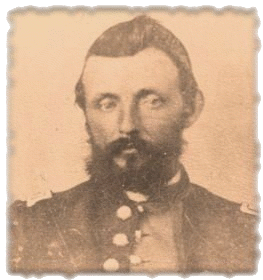
Captain Alexander Rush - Namesake of Rush County
| Pioneer Physician | Helium in Wartime | Lost Cordia | A North-South Railroad | The Forgotten Church |
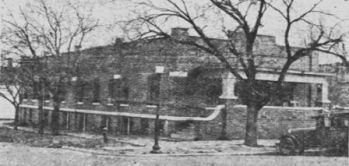
Pioneer Physician - Dr. J.H. Baker
One of the most well-known physicians in Rush County was Dr. J.H. Baker. Dr. Baker came to LaCrosse in the summer of 1915 and practiced until leaving two years later to serve in World War I. He returned to LaCrosse in 1919 to resume his practice, remaining in the Reserve Corps. He again left his practice to serve his country from 1942 to 1945 in World War II. During that time, he served as Chief Surgeon in four different military hospitals.
In 1924, Dr. Baker built a modern twenty-eight patient hospital in LaCrosse on the southeast corner of Main and Seventh streets. When reminiscing about Dr. Baker, locals who grew up in the community during the '30s and '40s have not-so-fond memories of a stay at the hospital for everything from a bout of the flu to a “trip downstairs to the surgery room.” Many Rush Countians were brought into this world with a slap of Dr. Baker's hand. His hospital served the area until 1950, when the county constructed a new hospital on the west edge of town. In later years the old Baker hospital building served as a rest home and apartment complex.
One of his most famous prescriptions was a homemade concoction known simply as “Brown Salve.” Many locals claim the salve, which was sold in a small metal tin with a handwritten label, was a virtual cure-all. The ingredients of the miracle medicine were a secret known only to the doctor himself.
Dr. Baker faithfully served the community for over fifty years. Like many country doctors, he is remembered for responding to calls throughout the county using various forms of transportation: wagon, horseback, automobile, and walking. It was a customary site in those days to see Dr. Baker “driving fast over the dirt roads of the county, raising great dust clouds behind him.”
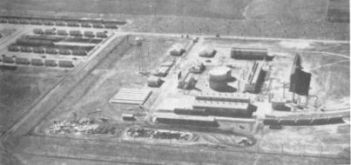
Helium in Wartime - Otis Helium Plant
In 1943, the United States Department of the Interior constructed a helium processing plant southeast of Otis. The following is an excerpt from the 1949 Rush County News - Diamond Jubilee Edition.
“The Bureau of Mines, world's sole producer of helium gas in quantity, constructed the 3-million dollar Otis Helium Plant in Rush county in 1943.
The plant was constructed to meet wartime demands of the armed services for the buoyant gas, helium, used in patrol blimps and weather and barrage balloons and for other war purposes.
The Otis plant is typical of the wartime plants constructed by the Bureau to extract helium from natural gas being transported to markets by commercial pipe lines. It processes gas from the Otis field in Rush and Barton counties, which like gas from several Kansas fields, contains a small percentage of helium—sufficient in this case for economical extraction. In this instance about 1.4 per cent.
The plant was built for the government under a cost plus fixed-fee contract used virtually exclusively in such construction at that time. At the peak of the construction period, the contractors employed between 300 and 400 men, many of whom were recruited from the immediate area. The plant was valued at $3,000,000 at the time of construction. Dr. C.W. Seibel, Supervising engineer of the Bureau of Mines Helium Plant, Amarillo, Tex., was contracting official for the government.
The plant had a high priority of materials and equipment. It was completed and went into operation ahead of schedule on October 21, 1943. Production was continuous until August 23, 1945 when the plant was placed in stand-by status at the close of the war.
The Bureau of Mines took over operation of the plant when it went into production. Between 75 and 100 persons were employed by the Bureau in operation of the plant. P.V. Mullins was engineer-in-charge and D.S. Taylor was assistant engineer-in-charge of the plant.”
The plant was located on an 80-acre tract of land one mile southeast of Otis. Streets were laid out and approximately 45 homes were constructed to house employees and their families creating a small town within the confines of the compound. The Missouri Pacific railroad constructed a spur to the plant to ship the processed helium in rail tank cars. A fence enclosed the area and guards were placed on 24-hour watch.
The government closed the plant after the war and it remained idle for a few years until being reactivated in 1951. During the 1960s, the plant employed about 40 people with 50% of its production used by NASA. The government officially abandoned the plant on April 30, 1968 and removed most the equipment. The houses were sold off and moved to surrounding communities for private use—many of which are still in use today. Attempts have been made to re-establish the area for industrial use, but none have been successful.
According to the Wichita Eagle, June 12, 1969, the United States government declared the plant surplus property and offered it for sale in April of 1969. J. Wayne Harrop, an official of the General Services Administration announced that Slocum Gas Co. of Dallas, Texas was the successful of 12 bidders offering $238,432 for the plant, five buildings, equipment and 100 acres of land. Although, citizens had hopes of the plant once again becoming an active industry for the community, plans never materialized. Today, the property and remaining buildings are privately owned.
In late 1963, oil industrialist, George Angle, constructed a new plant at the northwest corner of town adjacent to the highway. The plant was known as Kansas Refined Helium until it was sold in 1981 to Airco Industrial Gases.
Helium production is still a prominent industry in the Otis community. BOC Industrial Gases, a subsidiary of the Linde Group, operates what has become the world's second largest helium extraction plant in Otis. There are only about a dozen other plants of its kind in existence. Helium is used in medicine, industry, defense, electronics, and communication. The Otis plant produces helium for a variety of uses from Magnetic Resonance Imaging (MRI) to the balloons seen in the Macy's Thanksgiving Day Parade.
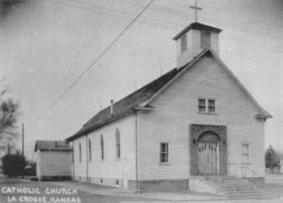
The Lost Village of Cordia, Kansas
“CORDIA, in Fairview Township, Rush County, Kansas, is an offshoot of Liebenthal, situated on the old trail connecting Hays and McCracken, about half way between these two cities.
The townsite is small, comprising but fifteen acres divided into lots. The whole plot was donated to the settlers, Joseph Legge, Fritz Oelkers and M. Close each giving five acres. The church property consists of five acres of land donated by Adam Jacobs, a member of the young community.
The Sacred Heart Corporation was formed July 1, 1920, and received its charter on August 5 of the same year. Five charter members were elected as soon as the charter was received. They are: Matt Herrmann, Adam Jacobs, Alex Munsch, Jacob Ronda and John Kreutzer. The last named is also Trustee.
Construction on Sacred Heart Church was begun in 1920, and the building completed on October 1, 1921. The new edifice was dedicated by Rt. Rev. Aug. J. Schwertner, Bishop of Wichita, on November 15, 1921.
In the spring of 1922 work was begun on a rectory, which was completed within a few months.
Rev. J. J. Steines has spiritual charge of the new settlement, in which divine services were held for the first time on October 15, 1921. On this occasion twelve families attended. Since then, the number of families has risen to twenty-seven, and there are good prospects for a slow but steady increase.” (Transcribed from: The Golden Jubilee of German-Russian Settlements of Ellis and Rush Counties, Kansas, August 31, September 1 and 2, 1926.)
The settlement, located one-half mile east of the townsite of Saunders, never consisted of much more than a church and rectory. Having never been incorporated or having a post office, the community does not appear on maps of the time.
In 1922, St. Michaels Parish of LaCrosse (founded in 1911) became a mission of the Cordia church. By 1929, the Sacred Heart Parish was in dire financial circumstances, while the LaCrosse congregation was growing rapidly. This prompted the Rt. Rev. August J. Schwertner, Bishop of Wichita, to move Rev. Fr. Hard, resident Priest in Cordia, to LaCrosse. The residents of Cordia agreed to sell their rectory to LaCrosse for about $5,000 and in spring of 1929, the house was moved to the corner of 9th & Lincoln Streets in LaCrosse. This move relieved Cordia's financial burden and secured a permanent rectory for LaCrosse where it stood until being dismantled in the mid-1960s.
Eventually, the Cordia congregation disbanded and on May 22, 1944 the church building was moved to LaCrosse. There it served the congregation of St. Michaels Parish who, by then, had outgrown its existing building which stood near the corner of 9th and Lincoln Streets adjacent to the rectory. The Cordia church building was placed on a basement facing Lincoln Street in the same block as the existing church and rectory. It continued to be used for Masses until a new brick church was completed in 1962. From that time it served as a Parish Hall and gymnasium for the adjacent school It was razed in the late 1970s.
All that remained of Cordia was the cemetery located east of the church site in the NE corner of the NW of section 16, township 16S, Range 19W (Lat. 38.669 N Lon. 99.429W). The cemetery served as a resting place for only fifteen infants buried in the 1920s. On April 27, 2013, their remains were exhumed and reinterred at St. Joseph's Cemetery in Liebenthal.
Sources:“The Golden Jubilee of German-Russian Settlements of Ellis and Rush Counties, Kansas, August 31, September 1 and 2, 1926.,”" 1926
Penka, Bradley R., “Cordia, Kansas - A Roman Catholic Settlement,” LaCrosse, Kansas, 2008
“The LaCrosse Republican,” LaCrosse, Kansas, Thursday, May 5, 1932
Reynolds, Judith, etal, “Rush County, Kansas - 125 Years in Story & Pictures,” Rush County Historical Society, LaCrosse, Kansas, 1999
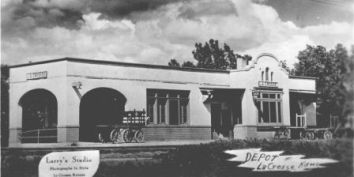
A North-South Railroad in Rush County
During the county's 125 year history, at least 27 charters were filed for railroads planning a route through Rush County. Most never made it beyond the planning stages. In the end, only two railroad lines ever reached completion; the Missouri-Pacific and Atchison, Topeka & Santa Fe. One of the most eventful and controversial attempts was the Gulf, Hutchinson, & Northwestern (GH&N) planned to traverse the county from south to north rougly along the route of today's U.S. Highway 183.
The GH&N was chartered March 21, 1901 in Hutchinson with Eugene Tilleux as president. Their planned route originated at Hutchinson and entered Rush County southeast of Rush Center. The route connected with the Atchison, Topeka, & Santa Fe east of Rush Center, and the Missouri-Pacific a block east of Main Street in LaCrosse. The route proceeded north to the Union Pacific Railroad in Hays and beyond.
By the end of 1905, crews completed surveying in Rush County and the City of LaCrosse proposed an ordinance granting the railroad a right-of-way down the middle of Peace Street.
In December of 1905, $5,000 in capital had been secured and 25 grading scrapers and a host of other equipment were unloaded at the Missouri-Pacific Depot in LaCrosse. A few days later, crews broke ground and grading commenced three-quarters of a mile north of Liebenthal. The LaCrosse Republican reported that "...fifty sturdy German farmers from Big Timber township have signed an agreement to work on tha [sic] grade this winter with teams at three dollars per day per man and team. They are to take half their wages in cash, and the other half in railroad stock to be paid in freight and passenger transportation when the road is constructed and equipped.”
Only about 15 miles of grading was completed (barely 2 miles being in Rush County) before the railroad apparently ran short of capital and abandoned plans to build through Rush County.
Today, portions of the grade can still be seen one mile north of Liebenthal just inside of the fence on the west side of Highway 183.
Source:Penka, Bradley R., “Rail Asperations - Railroad Chronicals of Rush County, Kansas 1850-1999” unpublished
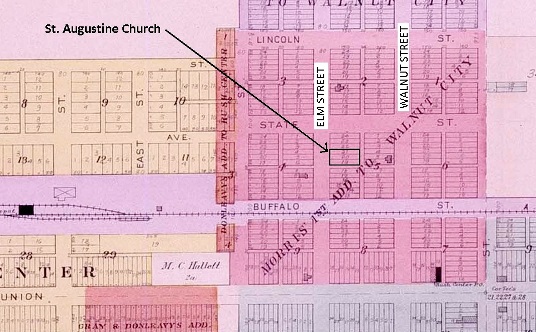
The Forgotten Church of Walnut City (Rush Center)
In the 1880s Walnut City experienced a period of rapid growth. The Chicago, Kansas & Western Railroad was building toward the community, and although in the midst of a bitter county seat war, Walnut City had aspirations of being the permanent seat of Rush County.
The Roman Catholic community had organized a parish in 1881 as a mission of the Capuchin friars of St. Fidelis in Victoria. In 1884, the parish became a mission of St. Joseph in Liebenthal under the service of Father William Bitter. However, the parish had no permanent building.
On March 2, 1886, for the sum of $150, August J. Bellport purchased and deeded three lots in the northwest part of Walnut City to Right Reverend Louis Mary Fink, Bishop of Leavenworth. The property was located one-half block north of the railroad right-of-way on Elm Street. Along with the building lots, Bellport contributed money to purchase the lumber to erect a new church. The parish was named for the patronage of St. Augustine and it is believed the name was chosen out of respect for Mr. Bellport who also provided land for a cemetery.
On March 3, 1886, The Herald - Walnut City reported, “Reverend Father Bitters, the new priest for this circuit was in the county on Monday last and selected a site and purchased ground on which to erect a Catholic church. We understand the preliminaries are being arranged and work will be commenced at once.” Construction commenced on the building in late June and the building was in use a short while later. The dedication was held on Tuesday, September 21, 1886. The Catholic Church brought the number of churches in the community to three including the Methodist Episcopal and Congregational churches completed earlier that year.
In 1888, the church was listed as one of 23 missions of St. Anthony Church in Olmitz under the leadership of Father John Disselkamp. However, the parish was deeply in debt and unable to continue. On May 4, 1888, Right Reverend Louis Mary Fink, Bishop of Leavenworth transferred the property by a quit claim deed back to August J. Bellport in consideration for his having provided land and building materials.
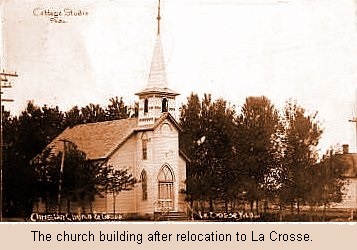
In 1891, Bellport sold the building to the congregation of First Christian Church in La Crosse and the building was moved to a site at the northwest corner of 9th and Elm in La Crosse (Lots 10-11, Stubbs & Delaplains Addition.) When the Christian Church constructed a new building in the 1920s, the Serpan family remodeled the church into their home. Although significantly altered, the building still stands today.
In the 20th century, there was a second attempt to establish a congregation. From 1907 to 1909, Rush Center and La Crosse were listed as separate stations of the Capuchins of Marienthal. After 1909, the Catholics of Rush Center joined other parishes in the county and the church's history slowly faded into the annals of time.
Sources:
The Herald - Walnut City - various issues March through July 1886
Plat Book of Rush County, Kansas, North West Publishing Co., Minneapolis Minnesota, 1901
Wenzl, Timothy F., “A Legacy of Faith: The History of the Diocese of Dodge City,” Catholic Diocese of Dodge City, Kansas, 2001